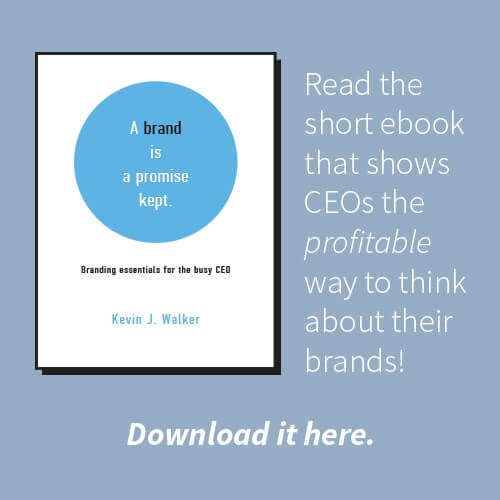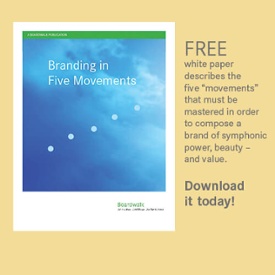 Return on investment. Buy low, sell high! We all know the basic objective of business. Cover your costs, earn a profit and generate wealth. And repeat. It sounds so simple and yet thousands of businesses flounder and die every year. How do businesses fail? There are too many ways to count. But some fail because they focus solely on making money and forget they exist to serve a purpose – a purpose to the market. Some forget, or never realized in the first place, that they have a brand promise to keep. The market expects them to deliver on it and, if they don’t, the market will not reward them with repeat business. That’s a recipe for tepid sales or, at worst, a going-out-of-business sale. But how does a business, even one that has formalized its brand strategy, know when it’s staying on-brand? How can it keep from drifting into territories that will dilute its relationship with the market? With the ROI/ROBP grid. That’s how.
Return on investment. Buy low, sell high! We all know the basic objective of business. Cover your costs, earn a profit and generate wealth. And repeat. It sounds so simple and yet thousands of businesses flounder and die every year. How do businesses fail? There are too many ways to count. But some fail because they focus solely on making money and forget they exist to serve a purpose – a purpose to the market. Some forget, or never realized in the first place, that they have a brand promise to keep. The market expects them to deliver on it and, if they don’t, the market will not reward them with repeat business. That’s a recipe for tepid sales or, at worst, a going-out-of-business sale. But how does a business, even one that has formalized its brand strategy, know when it’s staying on-brand? How can it keep from drifting into territories that will dilute its relationship with the market? With the ROI/ROBP grid. That’s how.
When we say a brand is weakening, what we’re really saying is the marketable asset, whether it’s a business, a product, a service, etc., is in a relationship with its market and that relationship is weakening. Symptoms of a weakening brand could be soft sales, diminishing repeat business, competing on price alone, etc. It’s best not to let things get this far. It’s best to stick with your brand strategy. It is possible, with a little technique known as the ROI/ROBP grid, to periodically assess a marketable asset’s activities and measure the strength and or weakness of the relationship it shares with its market. Thus, you measure the strength and weakness of the brand.
There are some prerequisites for this process. You need to already have a formalized brand strategy in place. You need clarity on what your brand is and what it means to your market. You have to understand what your market believes – feels – is your purpose in their lives. And you need to have put that strategy to work for a while. How long depends on the nature of the marketable asset.
For the sake of this example, let’s say the marketable asset in question is a professional services firm with a specialty. Let’s say it’s a certified public accountancy that specializes in forensic accounting. We’ll call the firm Acme.
And, again for the sake of the example, let’s say Acme has a unique competitive advantage within the field of forensic accounting, a secret sauce of some kind. Let’s call it a proprietary methodology they call 1-2-3. So their brand strategy is to become known as the forensic certified public accountancy that utilizes a brilliant methodology called 1-2-3.
Finally let’s assume that, after a year of executing their brand strategy, Acme decides to take stock and plot their recent projects on the ROI/ROBP grid. They have had seven major projects in the past year and they plot them out on the grid.
Ask Boardwalk to build you a brand strategy
with a high return on brand promise.

Project B is another story. Sometimes a project comes along that will take you off-brand but will yield a high ROI. In Acme’s case, B was a corporate audit that somehow found its way to them. It did not allow them to showcase their forensics methodology, 1-2-3. It was a highly profitable project but it did nothing to build their brand. Nothing wrong in accepting these kinds of projects from time to time but it would be a huge mistake for Acme to get greedy and start pursuing this kind of auditing work. That would weaken their brand strategy, weaken their relationship with their market, weaken their brand, weaken their business.
Project C, it should be obvious, represents the worst of all possible worlds: low ROI, low ROBP. No profit. No strengthening of the brand.
Project D represents a success in that Acme was able to delight another client on a forensic accounting job and again demonstrate the superior methodology of 1-2-3. Unfortunately, the project was not very profitable.
But, in general, Acme did a fairly good job this year. Most of their jobs were in the upper right quadrant, which represents the highest level of success. Only one job was in the lower left quadrant, which represents the lowest.
Now Acme knows that, next year, they need to get more and more of their projects into the upper right quadrant. Not only are those jobs highly profitable, on an individual basis, but, collectively, they tend to get the word out that 1-2-3 yields spectacular results. It is a superior approach to forensic accounting and only Acme can deliver it. A high return on brand promise builds the brand – and the value of the business – over the long term.
Try using this ROI/ROBP grid yourself to calculate the strength of your brand strategy. In your business, or for your product or service, what constitutes a high return on brand promise? Not sure? Let Boardwalk help you figure it out and start building your brand.
Best Branding Reads – Week of November 24, 2019
5 Keys To A Strong And Differentiated Culture
Between 50 and 67 percent of potential hires who turn down a job offer do it because they don’t like the offering company’s brand.
Merging Ethics, Culture And Campaigns
Not sure this article really delivers the magic formula but it’s still a worthwhile read.
Managing Brands In A Cancel Culture
When is it appropriate to sacrifice your authenticity in order to please your market?
Who Should Own a Cultural Change Project?
Agree with the author: Top management must 100% back the idea but representatives throughout the organization should do the work.
New Logo and Identity for Tentree
Truly, a delightful redesign … times ten!
Heritage Branding: Digitizing the Family Heirlooms
An interesting take on the recent trend towards “blanding”, particularly among long-established fashion houses
5 Ways Brands Can Avoid Getting Lost in the Passing Wellness Fad
Some very good advice here



